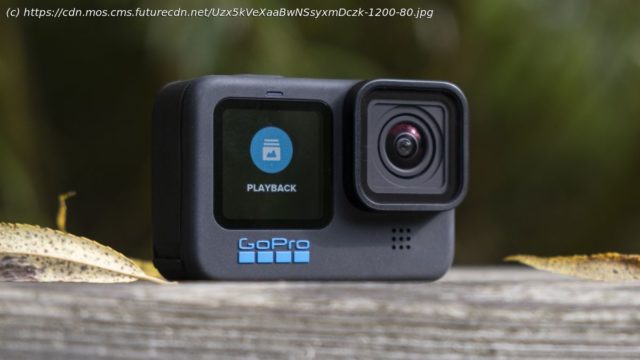The GoPro Hero 10 Black’s new GP2 processor makes it the most polished, versatile action camera you can buy, even if it isn’t a huge upgrade on its predecessor.
The GoPro Hero 10 Black is the latest in a long line of Hero action cameras that stretches all the way back to 2005. It’s the most polished, powerful GoPro so far thanks to its new GP2 processor, but it’s also only a relatively minor upgrade on its Hero 9 Black predecessor. Every so often GoPros make a big leap forward: the GoPro Hero 5 Black was waterproof without needing a case, and the Hero 7 Black introduced HyperSmooth stabilization. Despite its momentous name, the Hero 10 Black isn’t one of those models. But it does refine (and fix) most of the new features we saw on the Hero 9 Black, while adding a sprinkling of new shooting modes and better usability. The Hero 10 is built around the same 23MP 1/2.3in sensor as its predecessor and is waterproof down to ten meters, but it’s that new GP2 processor that unlocks most its new talents. Chief among these are some new shooting modes, including new 5K/60p,4K/120p and 2.7K/240p options. The latter two are fun, slo-mo affairs that are perfect for social media cut-scenes or b-cam footage. Particularly as GoPro’s revamped Quik app will happily do some of the editing for you. Other improvements include a much more responsive touchscreen interface (the Hero 9 Black fell down here), a handy new wired data transfer mode for phones, and some under-the-hood image quality boosts including local tone mapping and improved low-light noise reduction. There are certainly some minor improvements to video quality as a result, but the Hero 10 Black can still only do so much with its small 1/2.3in image sensor. More significant for most people will be that HyperSmooth 4.0 remains the best action camera video stabilization around, while watersports fan will enjoy the effective new hydrophobic coating on its toughened-up lens cover. It’s a shame that the Hero 10 Black hasn’t move up to a larger sensor like the Insta360 One R 1-Inch edition, while its recent moves into webcam and livestreaming continue to come with limitations on resolutions (still only 1080p) and platform support (although it is now possible to livestream with HyperSmooth stabilization). But despite its relatively conservative upgrades, the GoPro Hero 10 Black does nicely refine the image quality strides made by the Hero 9 Black, and is now the most user-friendly, powerful action camera you can buy – if not exactly the best value. The GoPro Hero 10 Black is available to buy now for $399 / £379 / AU$529 if you sign up for a GoPro Subscription, or for $499 / £479 / AU$669 on its own. It’ll also be available in India for Rs 54,500 from early November. The GoPro Subscription, formerly known as GoPro Plus, costs $49.99 / £49.99 / AU$69.99 per year when bought separately, and you’ll be set up to auto-renew annually if you buy the Hero 10 Black with a Subscription. But you can avoid that happening by cancelling the Subscription at any time during the first year. Given that you’re not obligated to renew the Subscription, it’s likely the best way for most people to buy the Hero 10 Black. Included in the GoPro Subscription is unlimited cloud storage for videos and photos at full quality, automatic uploads, full access to the Quik app’s editing tools,50% off all accessories (up to ten per year), live-streaming support, and replacements for broken cameras (for a fee, depending on the camera). The rest of the GoPro range will continue at their current prices with no models discontinued. This includes last year’s Hero 9 Black ($349 / £329 / AU$529), along with the Hero 8 Black ($279 / £259 / AU$419) and GoPro Max ($399 / £379 / AU$659). All of those prices are with a GoPro subscription, but again you can also buy them on their own without one. The GoPro Hero 10 Black is, physically, nigh-on identical to its predecessor. The only external difference from the Hero 9 Black is the new model’s fancy blue logos on the front and side. GoPro has made a couple of subtle tweaks, though. The big one for water sports fans is the new lens cover. This now has a hydrophobic coating, to help it repel water – and it really works. We ran the Hero 10 Black and its predecessor under a tap, and the new lens cover was significantly better at repelling water, leaving no droplets to obscure its view. This lens cover also apparently has greater scratch resistance, which was trickier to try out on our loan sample. Still, an unplanned test when our head-mounted GoPro flew off after a heavy zip-line landing and landed in some jagged wood chips resulted in no obvious marks on the lens. Like the Hero 9 Black, this lens cover is also removable if you do get serious damage, like a direct hit from an Airsoft pellet, or want to add ND (Neutral Density) filters. The Hero 10 Black is actually 5g lighter than its predecessor, although it’s impossible to tell exactly where it’s made this weight saving – and it brings no practical advantages anyway. Like before, it has folding ‘fingers’ for mounting it directly onto accessories in its base. These first appeared on the Hero 8 Black, and mean you don’t need to fiddle around with an extra housing to bolt it onto your helmet. If you’re not familiar with the Hero 9 Black, here’s a quick refresh of the other design features that the Hero 10 Black has inherited. There’s a 1.4in front LCD for vloggers, which GoPro says is now a little smoother when showing movement than before, thanks to some higher frame-rates powers by its GP2 processor (more on that later). This screen is so small though, we honestly couldn’t tell the difference from its predecessor. Far more noticeable is the improved 2.






